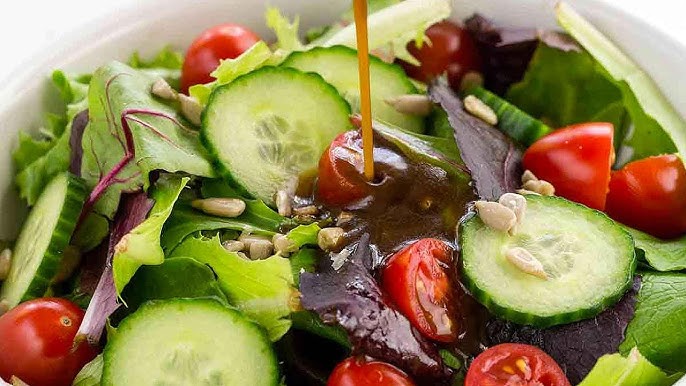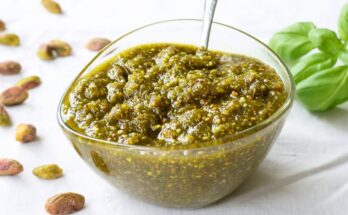Balsamic Vinaigrette Recipe: Balsamic vinaigrette is a simple yet flavorful dressing made by combining balsamic vinegar, oil, and seasonings. It’s a staple in many kitchens and can elevate the taste of salads, roasted vegetables, and even grilled meats. This tangy-sweet condiment pairs beautifully with a variety of dishes.
Why Make it at Home?
Making balsamic vinaigrette at home allows you to control the ingredients, avoid preservatives, and adjust flavors to your preference. Store-bought dressings often come with added sugar or artificial flavors. Homemade vinaigrette is fresher, healthier, and tastes better.
Ingredients Needed for Balsamic Vinaigrette
Key Ingredients and Their Role
- Balsamic Vinegar: The star ingredient that brings tanginess and sweetness.
- Olive Oil: Adds richness and balances the acidity.
- Dijon Mustard: Helps emulsify and provides a slight kick.
- Honey or Maple Syrup: Sweetens the vinaigrette and balances the tangy flavor.
- Garlic (minced): Adds a robust, savory note.
- Salt and Pepper: Enhances the overall flavor.
Optional Add-ins for Extra Flavor
- Shallots: For a mild oniony flavor.
- Herbs: Fresh thyme, basil, or parsley for an herbal touch.
- Lemon Juice: Adds brightness and enhances the acidity.
Step-by-Step Guide to Making Balsamic Vinaigrette
Step 1: Gather Your Ingredients
Start by assembling everything you need. Ensure the ingredients are fresh, especially the balsamic vinegar and olive oil. Quality ingredients make a big difference in taste.
Step 2: Measure and Mix
- Ratio to Remember: A standard balsamic vinaigrette recipe uses 1 part vinegar to 3 parts oil.
- Combine ¼ cup balsamic vinegar, ¾ cup olive oil, 1 teaspoon Dijon mustard, 1 teaspoon honey, and a pinch of salt and pepper in a bowl.
Step 3: Emulsify the Dressing
Whisk the mixture vigorously until the oil and vinegar blend into a smooth, creamy texture. For a quicker method, you can add all ingredients to a mason jar, seal it tightly, and shake until emulsified.
Step 4: Taste and Adjust
Taste your vinaigrette. Too tangy? Add a little more oil or a touch of sweetener. Too bland? Sprinkle in more salt or a splash of lemon juice.
Tips for the Perfect Balsamic Vinaigrette
Choosing the Right Balsamic Vinegar
Opt for high-quality balsamic vinegar labeled “Aceto Balsamico di Modena.” Aged varieties offer a richer and sweeter flavor.
Best Oils to Use
Extra virgin olive oil is the top choice for its robust flavor. However, you can experiment with lighter oils like avocado or grapeseed for a milder taste.
Balancing Flavors
- Sweeten with honey or maple syrup for balance.
- Add mustard for depth and a hint of spice.
- Use fresh herbs for complexity.
Ways to Use Balsamic Vinaigrette
As a Salad Dressing
This vinaigrette is perfect for leafy greens, especially arugula, spinach, or mixed greens with fruit and nuts.
Drizzle on Vegetables
Roasted vegetables like Brussels sprouts, carrots, and asparagus come alive with a drizzle of balsamic vinaigrette.
Use as a Marinade
Its tangy flavor works wonders for marinating chicken, beef, or tofu, making your proteins juicy and flavorful.
Storage and Shelf Life
How to Store Properly
Store your balsamic vinaigrette in an airtight container or jar in the refrigerator. Shake well before each use as separation is natural.
How Long Does It Last?
Homemade balsamic vinaigrette can last up to 2 weeks in the fridge, though fresh is always best.
Common Mistakes to Avoid
Overpowering Flavors
Avoid using too much balsamic vinegar as it can overpower the dressing. Stick to the recommended ratio.
Incorrect Ratios
Maintaining the 1:3 vinegar-to-oil ratio ensures a balanced vinaigrette. Too much oil makes it bland, while too much vinegar makes it harsh.
Health Benefits of Balsamic Vinaigrette
Nutritional Value
Balsamic vinegar is low in calories and contains antioxidants, while olive oil is a source of healthy fats.
Why It’s a Healthy Choice
This dressing is free from preservatives and loaded with nutrients, making it a guilt-free addition to meals.
Variations of Balsamic Vinaigrette
Creamy Balsamic Vinaigrette
Blend in a tablespoon of Greek yogurt or mayonnaise for a creamy texture.
Honey Balsamic Vinaigrette
Increase the honey or use maple syrup to create a sweeter version that pairs well with fruit salads.
FAQs about Balsamic Vinaigrette Recipe
What is balsamic vinaigrette made of?
Balsamic vinaigrette is a simple dressing that typically includes balsamic vinegar, olive oil, garlic, mustard, and a sweetener like honey or sugar. Some recipes may also include herbs and spices for added flavor.
How long can you store homemade balsamic vinaigrette?
Homemade balsamic vinaigrette can be stored in the refrigerator for up to 2 weeks. Ensure it’s kept in an airtight container and give it a good shake before use, as the ingredients may separate over time.
Can balsamic vinaigrette be used as a marinade?
Yes, balsamic vinaigrette works excellently as a marinade for meats like chicken, beef, and pork. Its acidity helps to tenderize the meat while the flavors enhance the overall taste.
Is balsamic vinaigrette gluten-free?
Balsamic vinaigrette is naturally gluten-free, but it’s important to check the labels of the ingredients used, especially the balsamic vinegar and mustard, to ensure they do not contain any hidden gluten.
What are some variations of balsamic vinaigrette?
You can customize your vinaigrette by adding different ingredients like crushed red pepper for heat, fresh herbs for a vibrant taste, or swapping the balsamic vinegar with red wine vinegar for a different flavor profile.
Conclusion
Balsamic vinaigrette is a versatile, easy-to-make dressing that can transform your meals. With just a few simple steps, you can create a delicious, healthy condiment tailored to your taste.
There’s no better time to ditch the store-bought bottles and whip up this flavorful vinaigrette. Your salads, veggies, and marinades will thank you!



